Dr. Phil Zeltzman’s Blog
5 (more) things every dog owner should know
In addition to our previous tips, here are a few more tips pet owners should be aware of, to keep their pets happy and healthy.
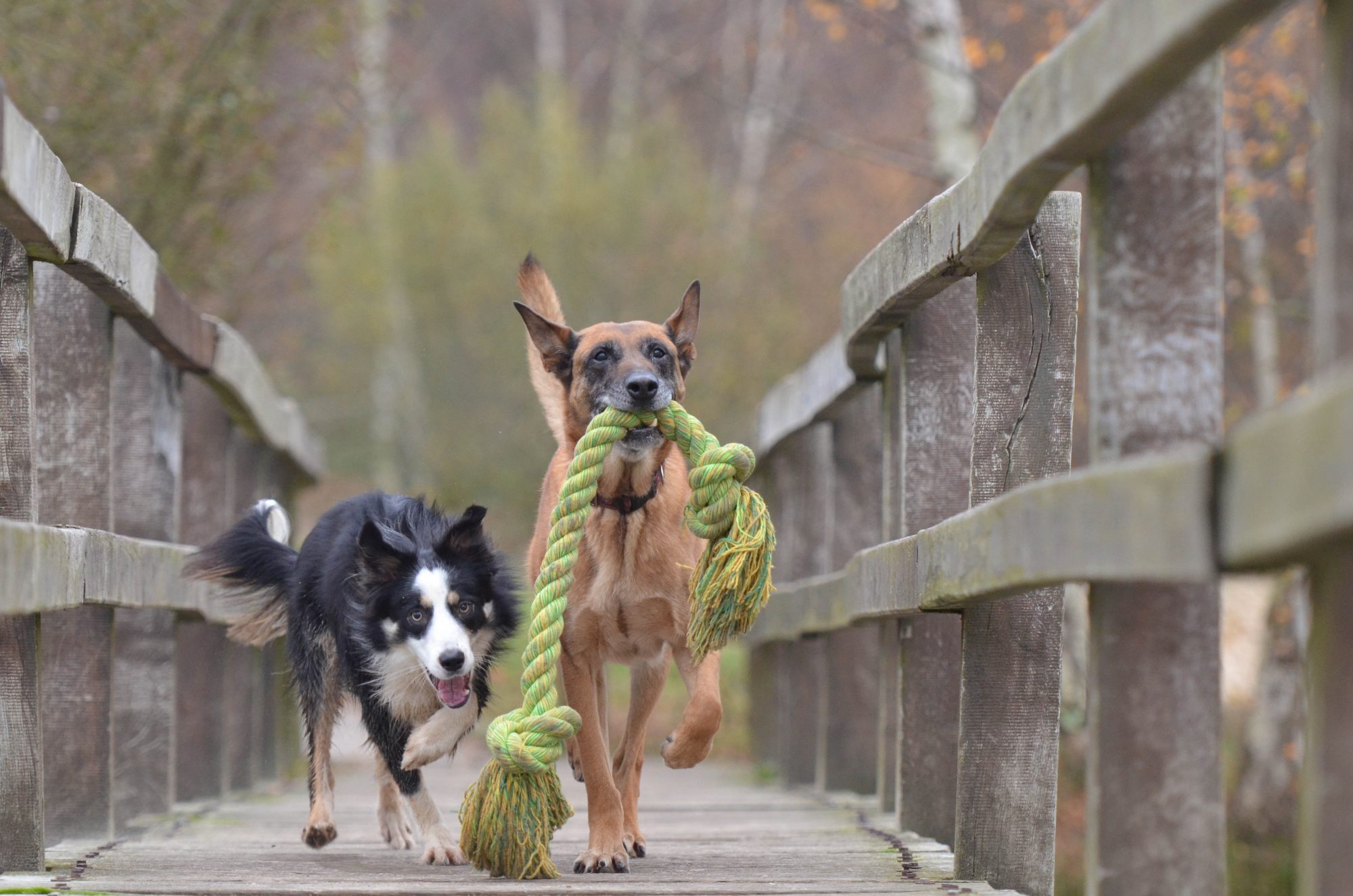
6. Follow discharge instructions
Discharge instructions are made to be followed.
We know that wearing a plastic cone for 2 weeks is no fun. But neither is an infection. Or worse, a second surgery to stitch up an incision that was opened!
We know that being stuck in a small room or a crate for 4 to 8 weeks is boring. If there were an easier way to do things, we would tell you! So please follow discharge instructions, all of them, all of the time.
7. Get pet insurance
Pet insurance can make all of the difference in your dog’s life. If you cannot afford thousands of dollars in emergency or medical care, please consider getting pet insurance. And do your homework, as there are some really bad and really good companies out there.
8. Know thy enemy
Anesthesia is not the enemy. Surgery is not the enemy. Your dog’s condition is the enemy. We are here to help you choose the best weapon to fight the enemy.
9. Prevention is a critical part of dog medicine
Every year, countless dogs die because they did not receive basic, effective, affordable preventive care. All dogs should receive an annual exam, all vaccines recommended by your vet or required by law in your State and preventive medications against fleas, ticks and heartworms year round.
10. Don’t inadvertently starve your dog
Cutting a dog’s food (or worse, a cat’s) in half can have serious negative consequences.
When you realize it’s time for your dog to lose weight, be sure to create a safe plan with your family vet.
We would rather have you trust us, and feed a diet that was made specifically for weight loss. It will have fewer calories, may have more fiber to fill the stomach, or may trick your dog’s brain into thinking that he or she is not hungry anymore.
Yet it will have all of the nutrients and vitamins required.
At the very least let’s review the diet together.
Phil Zeltzman, DVM, DACVS, CVJ, Fear Free Certified

Dr. Phil Zeltzman is a traveling veterinary surgeon in Pennsylvania & New Jersey. An award-winning author, he loves to share his adventures in practice along with information about vet medicine and surgery that can really help your pets. Dr. Zeltzman specializes in orthopedic, neurologic, cancer, and soft tissue surgeries for dogs, cats, and small exotics. By working with local family vets, he offers the best surgical care, safest anesthesia, and utmost pain management to all his patients. Sign up to get an email when he updates his blog, and follow him on Facebook, too!
You did cosmetic surgery on your dog’s WHAT???
Piper, a 6 year old Labrador, had battled bladder infections for her entire life. They cleared up with antibiotics, but kept coming back.
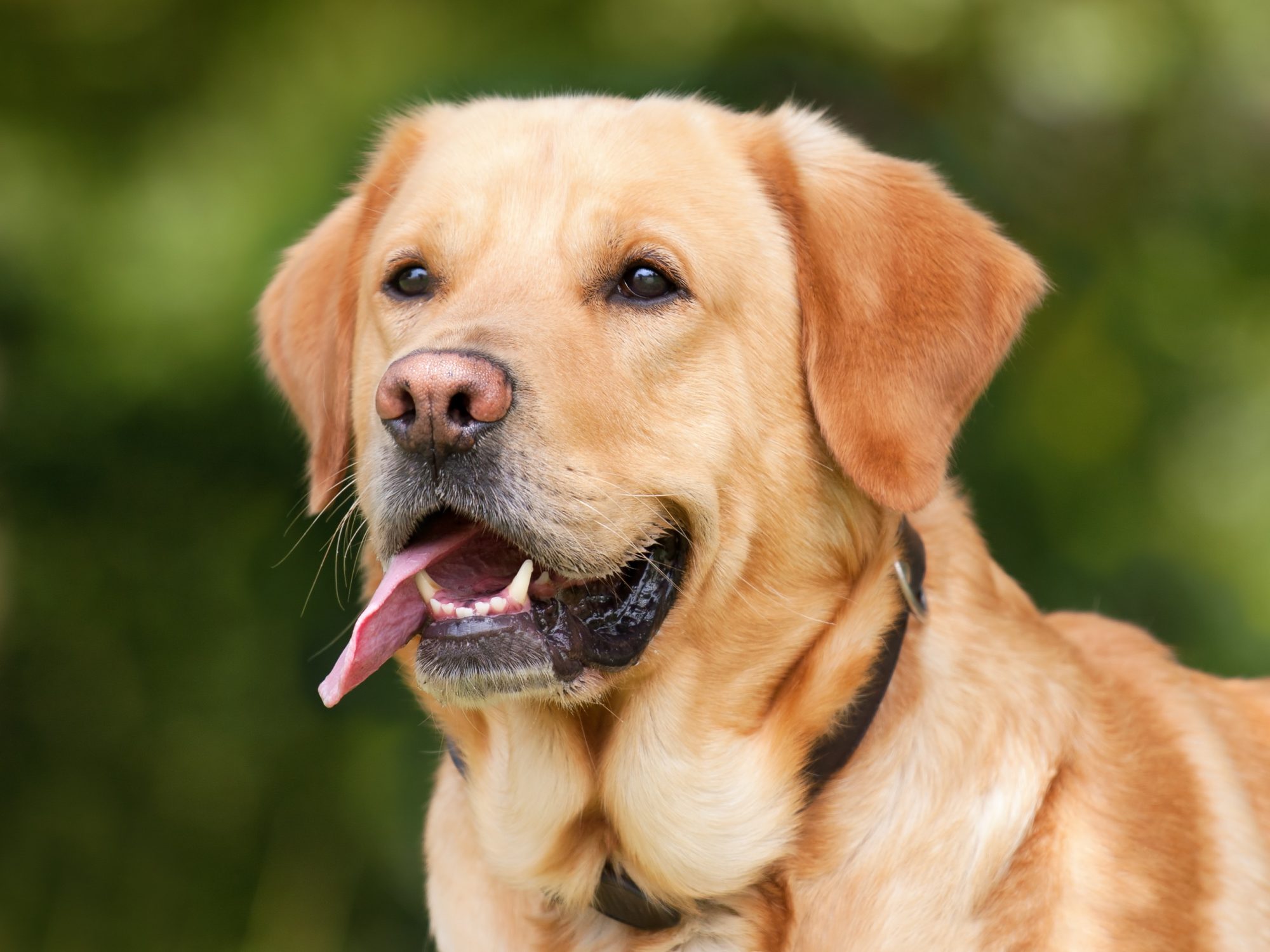
Her family vet at South Mountain Veterinary Hospital (www.southmountainvethospital.com) diagnosed what is called a redundant vulvar fold, which is an extra fold of skin covering her vulva. It is also called “recessed vulva” or “vulvar fold dermatitis”. This is a fairly common condition, especially in overweight dogs, and many go un-diagnosed for years.
How can a skin fold cause bladder infections?
The extra skin fold creates a deep pocket that traps urine. In turn, this pocket creates a warm, moist and dark environment, which is perfect for bacteria to multiply. This causes ongoing infections and sometimes a foul odor. Here is a picture of Piper’s back end before surgery: you can’t see her vulva at all.
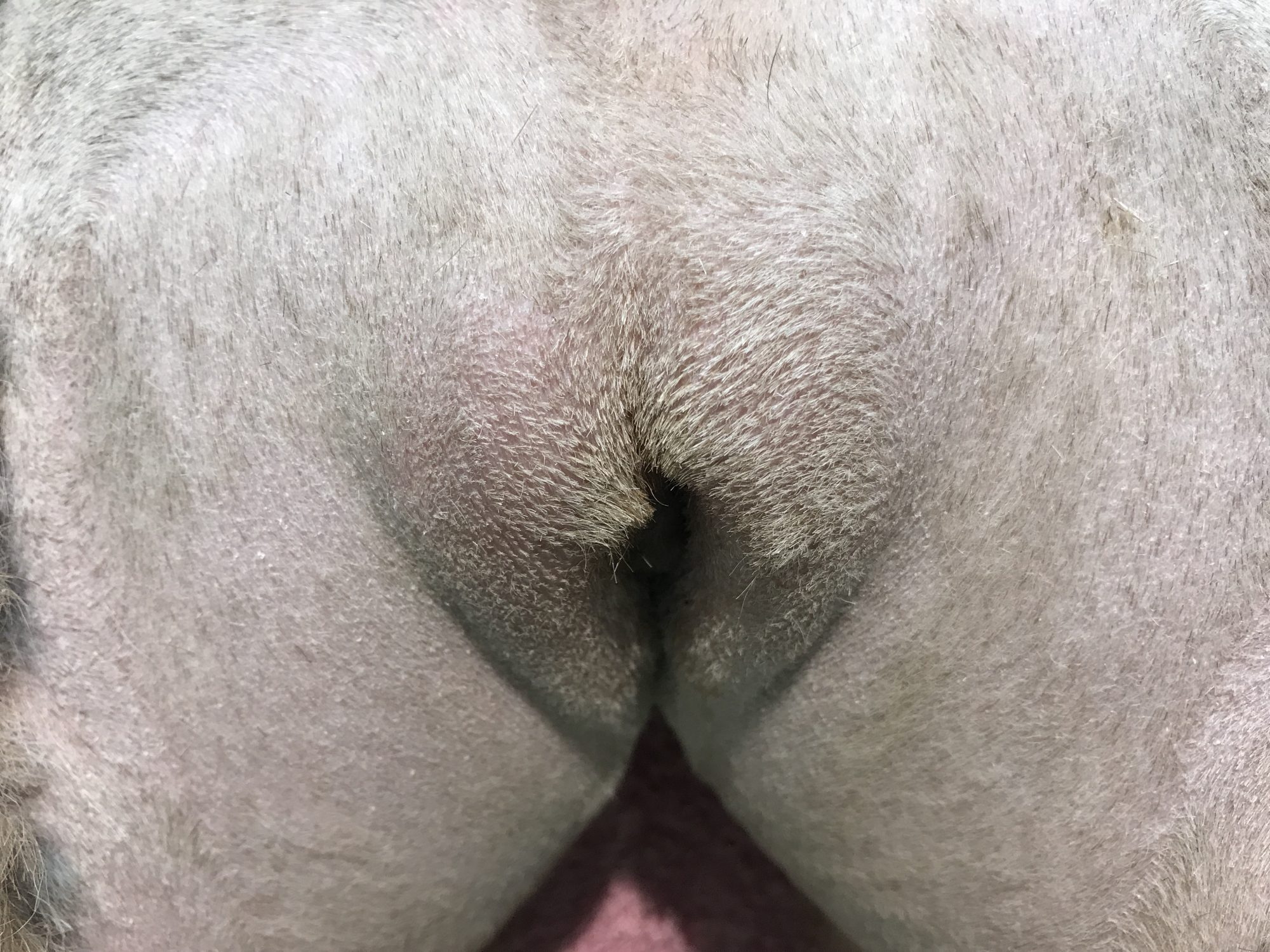
Signs of bladder infections may include licking of the vulva, scooting of the back end, bloody urine and “accidents” in the house. Other conditions may cause similar signs, so your family vet should eliminate other problems, such as bladder stones and even bladder cancer.
How can we fix this annoying condition?
- The Band-Aid approach is the “medical” treatment. We only treat the symptoms by wiping the area and prescribing antibiotics. This does not treat the cause, so it often frustrating because the infection is likely to come back.
- The ideal treatment is surgery. It’s basically plastic surgery on a dog’s vulva! Surgery involves removing the extra skin to provide better ventilation of the vulva.
This reconstructive surgery is called a vulvoplasty or an episioplasty. The main difficulty of the surgery is to remove exactly the right amount of skin: not too much and not too little. Here is a picture of Piper’s back end after surgery.
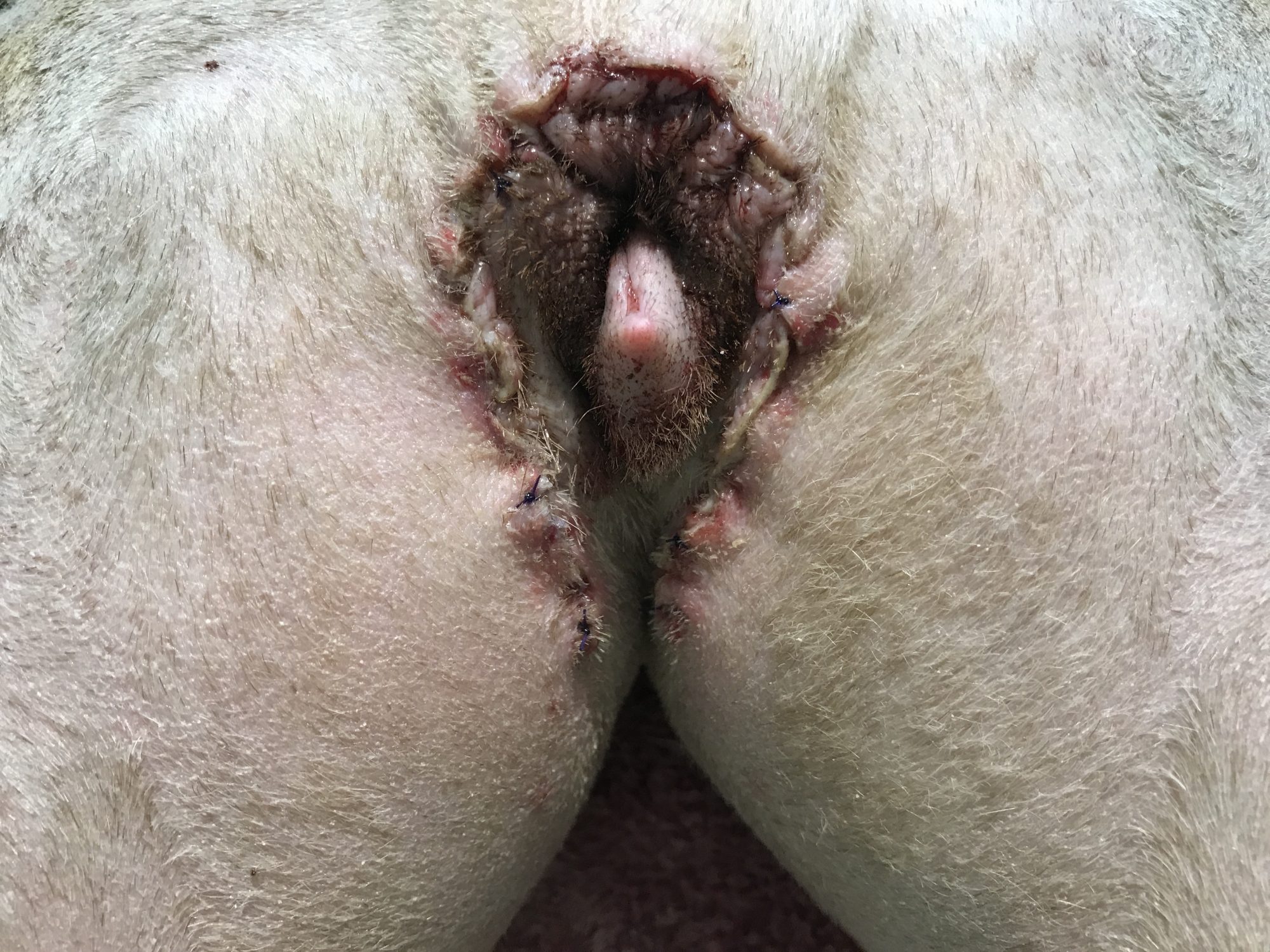
Recovery generally takes 3 weeks. I don’t use external skin sutures, so there are no stitches to remove in this sensitive area… All stitches are internal and eventually dissolve. An E collar (plastic cone) is worn for the full 3 weeks to prevent licking and to protect the incision.
Overall, this is a common yet frustrating condition. Fortunately, surgery is typically very successful and pet owners are usually very happy with the end result… as well as their dogs!

Dr. Phil Zeltzman is a traveling veterinary surgeon in Pennsylvania & New Jersey. An award-winning author, he loves to share his adventures in practice along with information about vet medicine and surgery that can really help your pets. Dr. Zeltzman specializes in orthopedic, neurologic, cancer, and soft tissue surgeries for dogs, cats, and small exotics. By working with local family vets, he offers the best surgical care, safest anesthesia, and utmost pain management to all his patients. Sign up to get an email when he updates his blog, and follow him on Facebook, too!
Two wise dog owners may save their dogs’ lives
Two dog owners recently asked me to do a preventive surgery on their dogs.
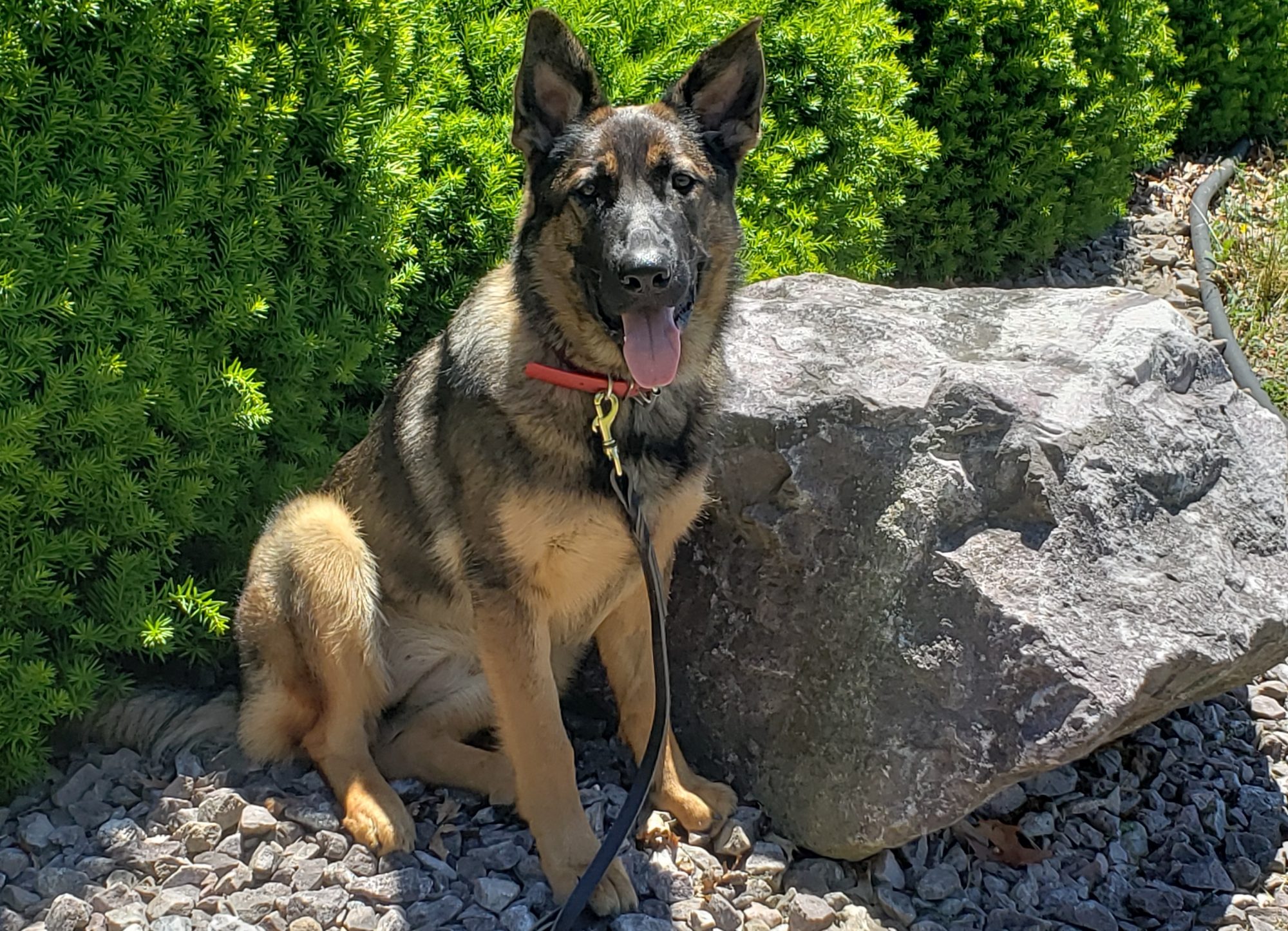
Their dogs, both German shepherds, are at risk for a deadly condition called “bloat.” This is a situation where the stomach becomes hugely distended with gas, and can in some cases twist onto itself.
The procedure is called a prophylactic gastropexy. The smartest time to do it is at the time of spaying or neutering, since the dog is already under anesthesia.
“Prophylactic” means that it’s a preventive surgery performed before this “bloat” condition actually occurs.
“Gastropexy” means that the stomach is tacked or stitched to the inside of the belly. This procedure prevents the twisting of the stomach.
It is a potentially life-saving procedure that should be considered in Great Danes (the #1 breed for this disease), German shepherds, Labs and several other large dog breeds.
And so Bella, a 6 month old German shepherd, had her gastropexy at the time of her spay.
And Zeke, a 1 year old German shepherd, had his gastropexy at the time of his neuter. Here is a picture of the completed surgery.
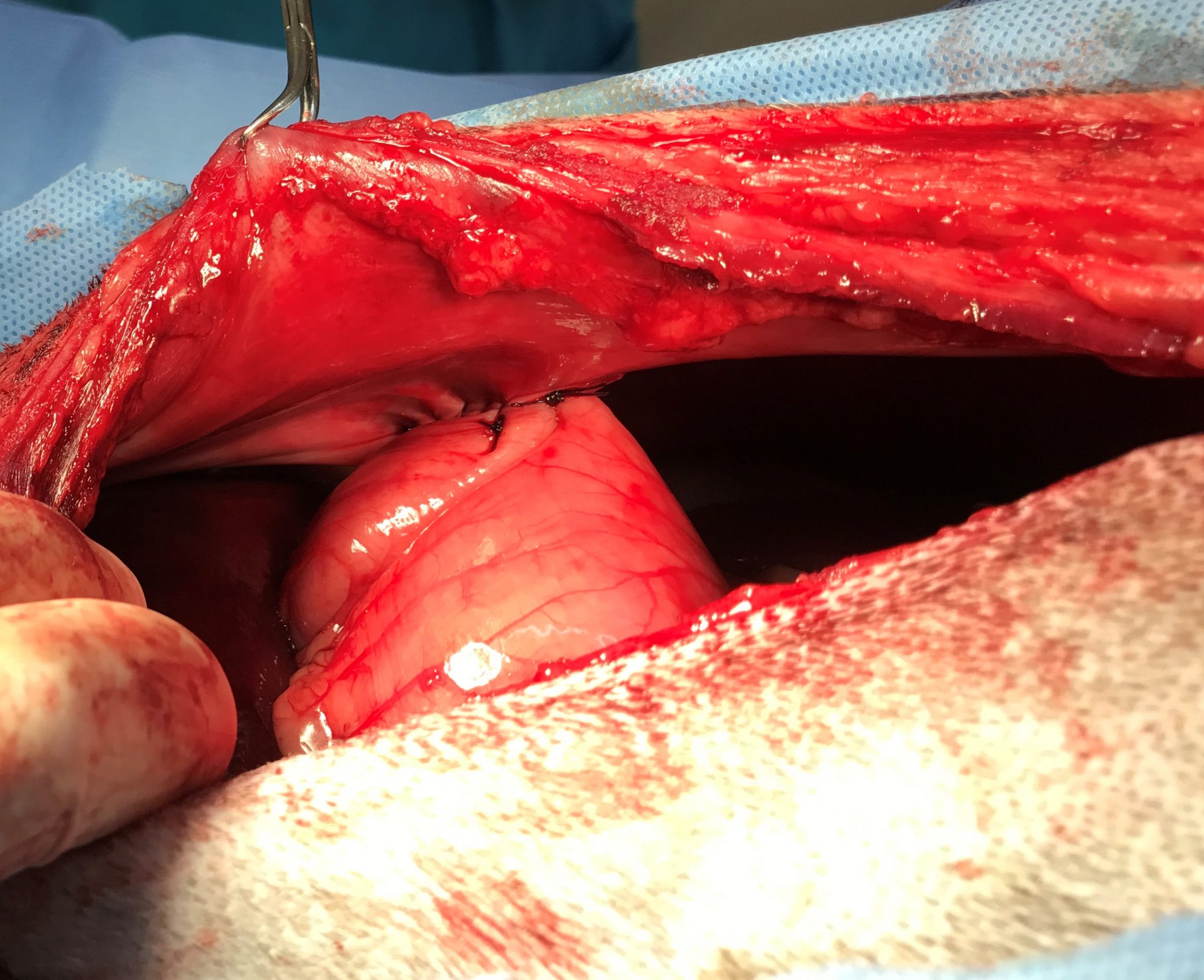
Now, it’s very important to understand that the gastropexy only prevents twisting of the stomach. It does NOT prevent actual bloat, where the stomach gets hugely distended with gas. This could still happen in the future. In that case, a vet would have to pass a tube down the throat to remove the gas out of the stomach. The dog would then need to be “stabilized” with IV fluids etc. But there should be no emergency surgery to untwist the stomach. Here is an X-ray of a twisted stomach to show you what I mean by “the stomach becomes hugely distended with gas.”
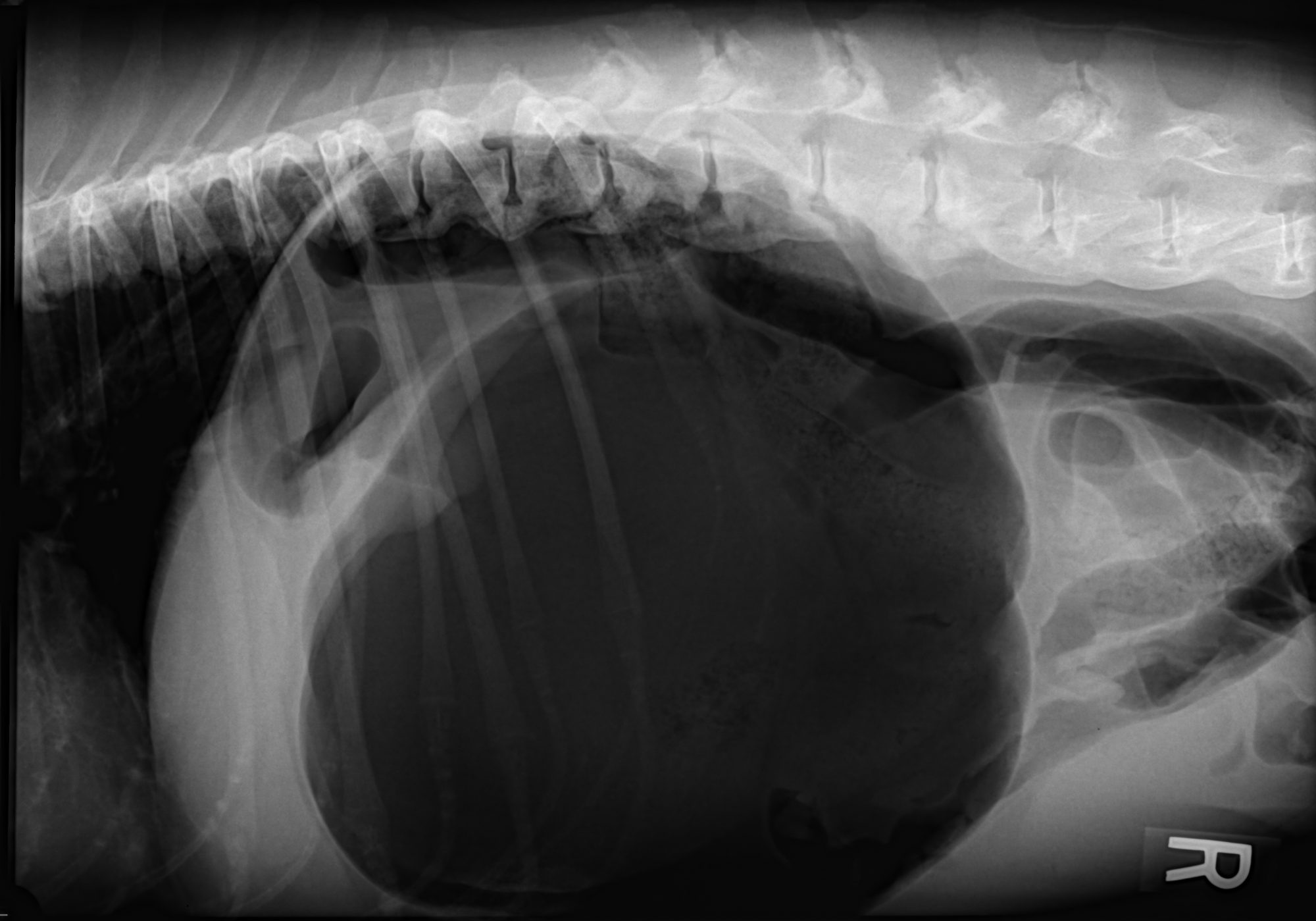
If your dog is at risk for “bloat”, please consider having him or her “gastropexied.” It can save their life.

Dr. Phil Zeltzman is a traveling veterinary surgeon in Pennsylvania & New Jersey. An award-winning author, he loves to share his adventures in practice along with information about vet medicine and surgery that can really help your pets. Dr. Zeltzman specializes in orthopedic, neurologic, cancer, and soft tissue surgeries for dogs, cats, and small exotics. By working with local family vets, he offers the best surgical care, safest anesthesia, and utmost pain management to all his patients. Sign up to get an email when he updates his blog, and follow him on Facebook, too!
Achilles was all broken after he got hit by a car…
Achilles, a 4 year old, 10 pound Yorkie, was hit by a car. His pelvis was broken in multiple places. The main issues were a fracture of the ileum (the bone in the front of the pelvis – red arrows) and a Sacro-Iliac luxation (aka SI luxation – blue arrows).
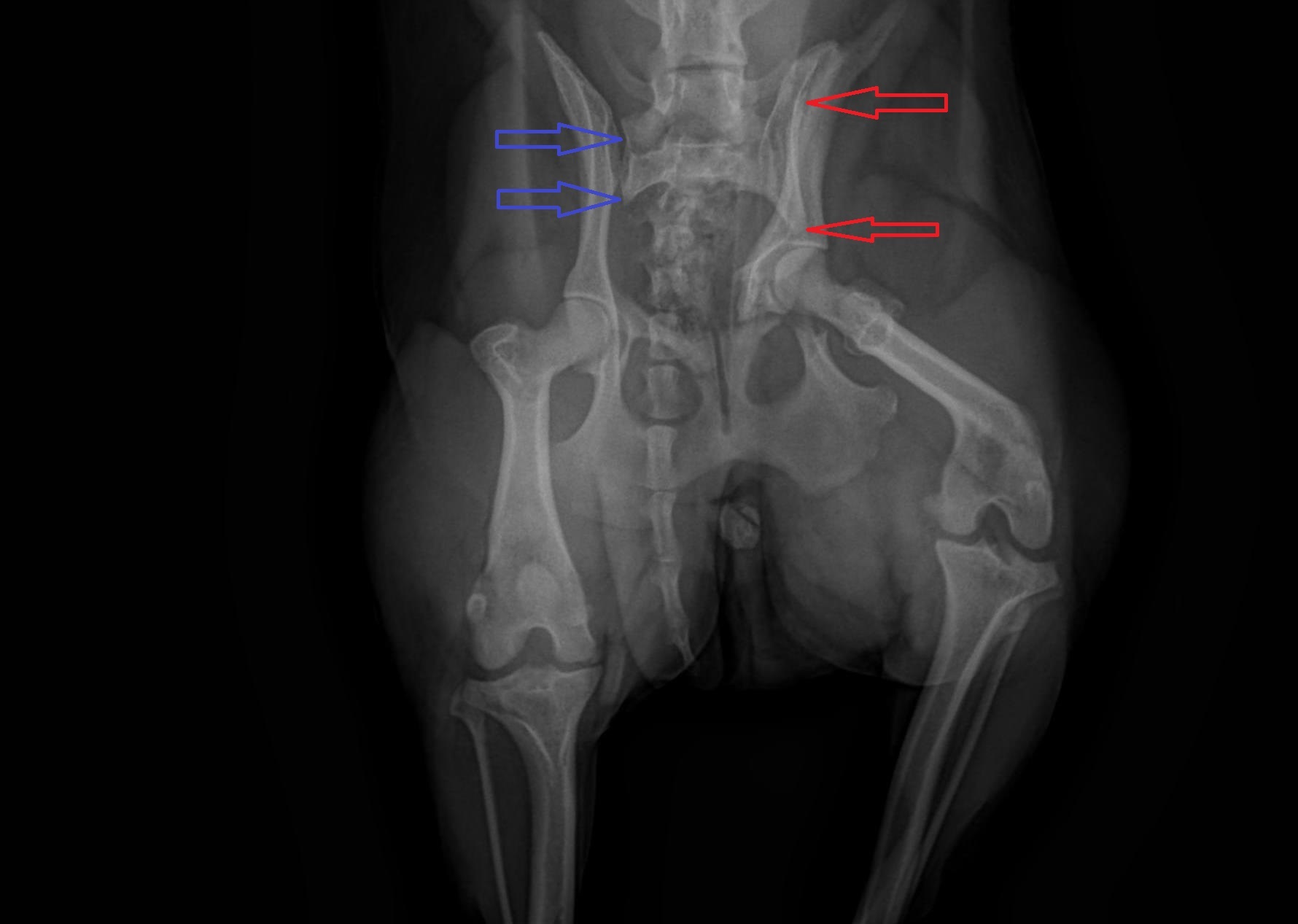
An SI luxation is a dislocation between the pelvis and the spine. Both injuries needed to be repaired surgically. There were several other fractures in the pelvis, which did not need surgery. In addition, there were multiple soft tissue injuries, meaning mostly damage to the muscles around the pelvis.
I was called to put Achilles back together at the Animal Clinic of Morris Plains in NJ.
The fracture was repaired with a metal plate and 6 screws. The dislocation was repaired with 1 pin and 1 screw (see postop X-ray).
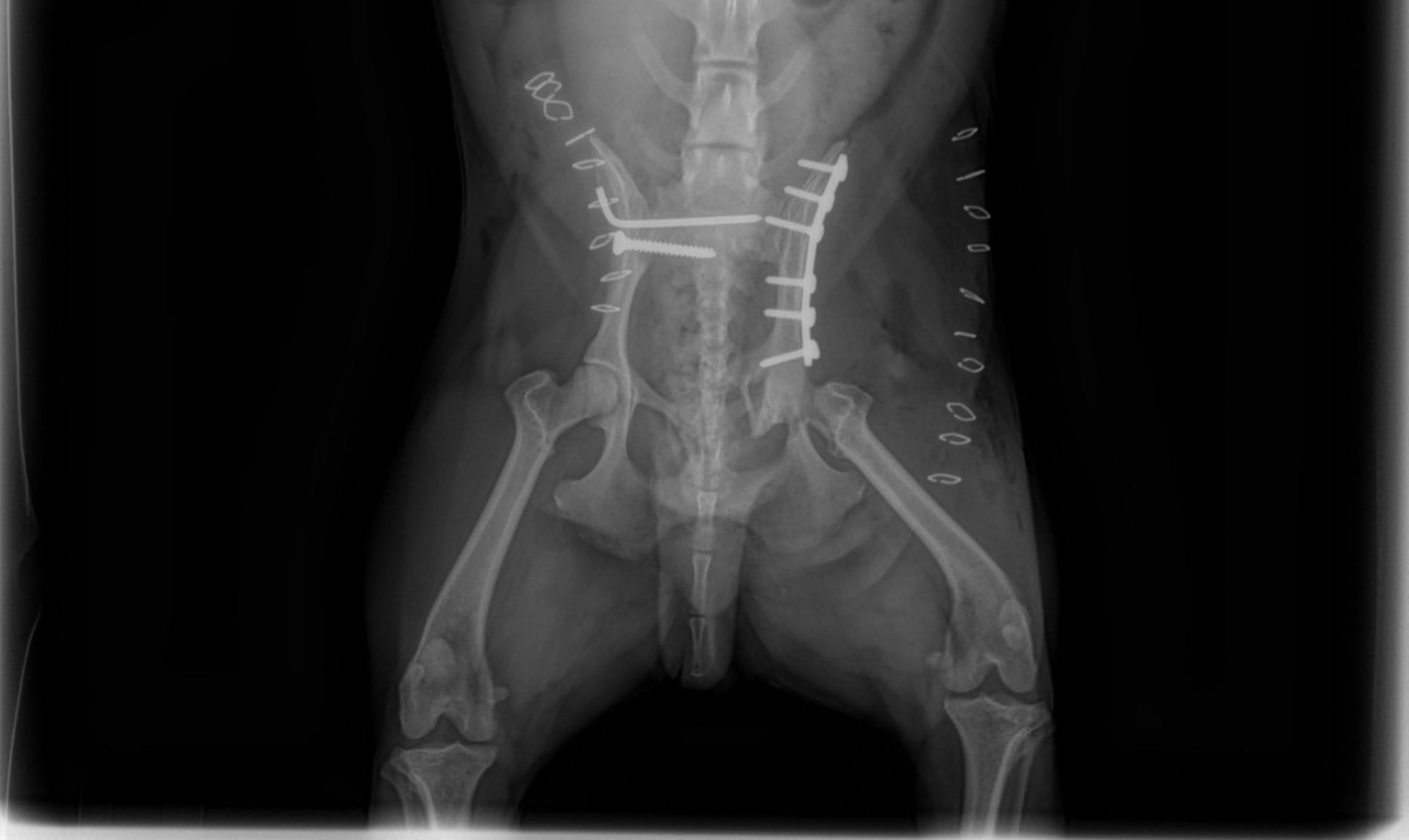
After surgery, Achilles will need to rest very strictly for 2 months. This will allow all of the fractures, repaired and unrepaired, to heal nicely.
This is sadly a common story. Dogs often jump out of a car, run out of a yard, chase cars, follow their instincts (often due to hormones) etc. In the end, the car always wins. Please keep your cats and dogs safe. A leash is the easiest way to avoid many problems.
Phil Zeltzman, DVM, DACVS, CVJ, Fear Free Certified

Dr. Phil Zeltzman is a traveling veterinary surgeon in Pennsylvania & New Jersey. An award-winning author, he loves to share his adventures in practice along with information about vet medicine and surgery that can really help your pets. Dr. Zeltzman specializes in orthopedic, neurologic, cancer, and soft tissue surgeries for dogs, cats, and small exotics. By working with local family vets, he offers the best surgical care, safest anesthesia, and utmost pain management to all his patients. Sign up to get an email when he updates his blog, and follow him on Facebook, too!

